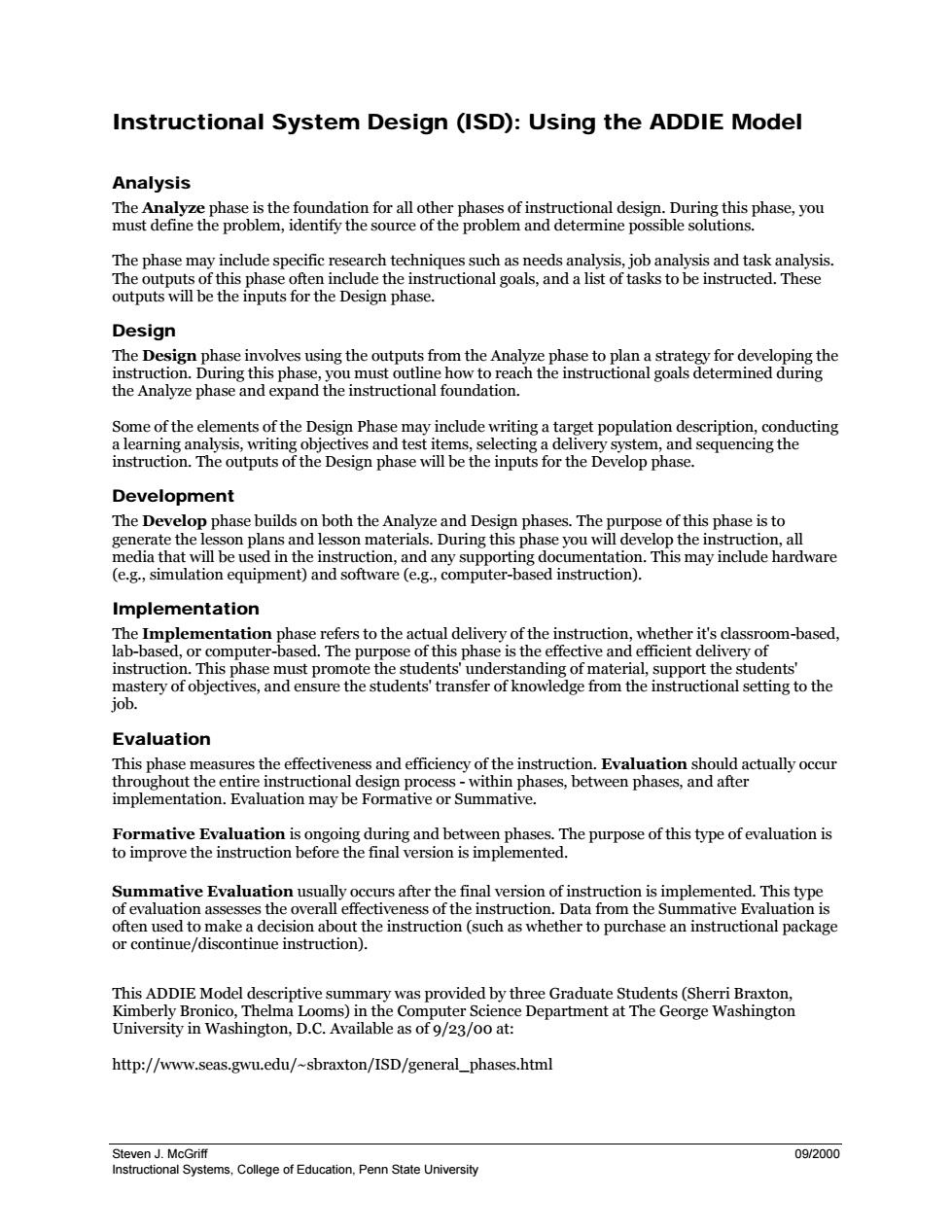正在加载图片...

Instructional System Design(ISD):Using the ADDIE Model Analysis The phase may include specific research techniques such as needs analysis,job analysis and task analysis. b the inputs for the Design phasercon nd ass tobe nsucted.mhese Design The Design phase involves using the outputs from the Analyze phase to plan a strategy for developing the ring th Some of the eler ents of the sign Phas may include egpoationkeeptionomdctng will be the inputs fo the sequencing th Development The Develop phase builds on both the Analyze and Design phases.The urpose of this phase is to During th ase you wi dwar (e.g.,simulation equipment)and software (e.g.computer-based instruction). Implementation instruction.This phase must promote the students understanding of material,sup oport the students' mo apalMouy jo ajsuen squapnis am amsua pue Evaluation This phase measures the effectiven s and efficiency of the instruction.Evaluation should actually occur een phases.The purpose of this type of evaluation is native evalu tion u s after the final version of instruction is implemented.This tyn of evaluation ass sses the overall effectiveness of the instruction.Data from the Summative Evaluation is instruc This ADDIE Model descriptive summary was provided by three Graduate Students(Sherri Braxton, 9/23/00 http://www.seas.gwu.edu/-sbraxton/ISD/general_phases.html 09/2000Steven J. McGriff 09/2000 Instructional Systems, College of Education, Penn State University Instructional System Design (ISD): Using the ADDIE Model Analysis The Analyze phase is the foundation for all other phases of instructional design. During this phase, you must define the problem, identify the source of the problem and determine possible solutions. The phase may include specific research techniques such as needs analysis, job analysis and task analysis. The outputs of this phase often include the instructional goals, and a list of tasks to be instructed. These outputs will be the inputs for the Design phase. Design The Design phase involves using the outputs from the Analyze phase to plan a strategy for developing the instruction. During this phase, you must outline how to reach the instructional goals determined during the Analyze phase and expand the instructional foundation. Some of the elements of the Design Phase may include writing a target population description, conducting a learning analysis, writing objectives and test items, selecting a delivery system, and sequencing the instruction. The outputs of the Design phase will be the inputs for the Develop phase. Development The Develop phase builds on both the Analyze and Design phases. The purpose of this phase is to generate the lesson plans and lesson materials. During this phase you will develop the instruction, all media that will be used in the instruction, and any supporting documentation. This may include hardware (e.g., simulation equipment) and software (e.g., computer-based instruction). Implementation The Implementation phase refers to the actual delivery of the instruction, whether it's classroom-based, lab-based, or computer-based. The purpose of this phase is the effective and efficient delivery of instruction. This phase must promote the students' understanding of material, support the students' mastery of objectives, and ensure the students' transfer of knowledge from the instructional setting to the job. Evaluation This phase measures the effectiveness and efficiency of the instruction. Evaluation should actually occur throughout the entire instructional design process - within phases, between phases, and after implementation. Evaluation may be Formative or Summative. Formative Evaluation is ongoing during and between phases. The purpose of this type of evaluation is to improve the instruction before the final version is implemented. Summative Evaluation usually occurs after the final version of instruction is implemented. This type of evaluation assesses the overall effectiveness of the instruction. Data from the Summative Evaluation is often used to make a decision about the instruction (such as whether to purchase an instructional package or continue/discontinue instruction). This ADDIE Model descriptive summary was provided by three Graduate Students (Sherri Braxton, Kimberly Bronico, Thelma Looms) in the Computer Science Department at The George Washington University in Washington, D.C. Available as of 9/23/00 at: http://www.seas.gwu.edu/~sbraxton/ISD/general_phases.html